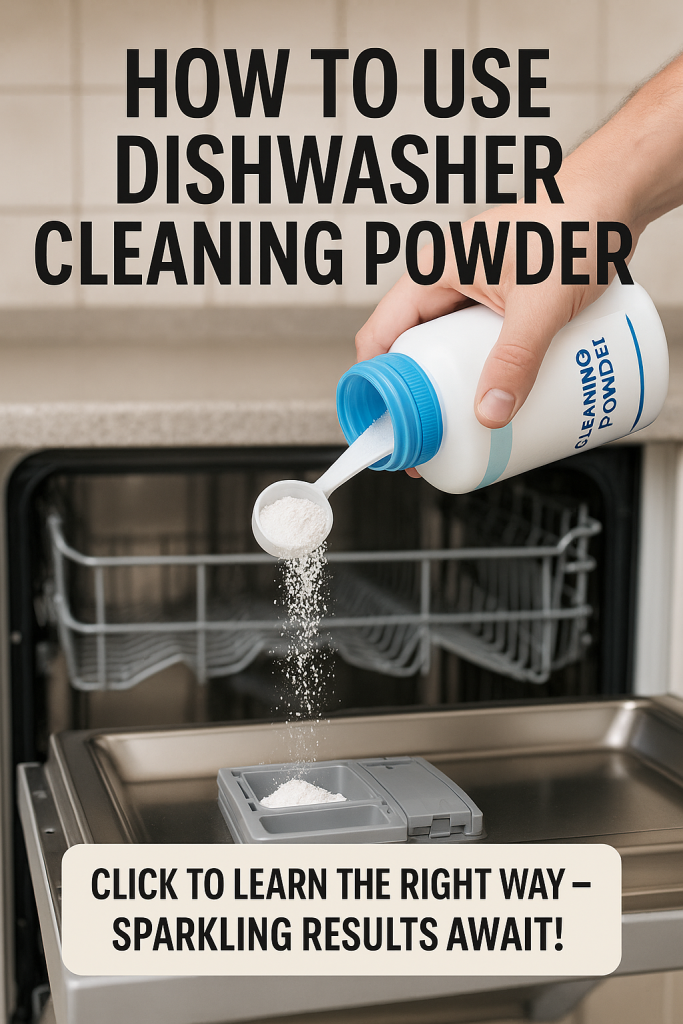Alright, picture this: you’ve just loaded up your dishwasher with last night’s pasta plates, a couple of wine glasses (because, priorities), and that one pan you swore you’d soak “just for a minute” but left overnight. You grab the box of dishwasher powder and—freeze. Wait. Do you just throw it in? Sprinkle it like fairy dust? Dump half the box because “more soap means cleaner dishes,” right? (Spoiler alert: nope.)
Here’s the deal—using dishwasher cleaning powder isn’t rocket science, but there is a right way to do it if you want sparkling glasses instead of cloudy ones, and fresh-smelling plates instead of…well, that weird musty smell.
Think of this article as your “no judgment, let’s figure this out together” guide to using dishwasher cleaning powder the smart way. Because, let’s be honest, nobody wants to waste time rewashing dishes or, worse, open the dishwasher to find a foamy disaster scene straight out of a sitcom.
But before we dive into the “how,” let’s clear up one thing first: what even is dishwasher cleaning powder, and how’s it different from those pods or gels everyone talks about?
What Dishwasher Cleaning Powder Actually Is (and Why It’s Not Just Fancy Laundry Soap)
Okay, quick question: have you ever been tempted to toss laundry detergent into your dishwasher because you ran out of the “real” stuff? (Be honest—we’ve all thought about it for half a second.) Well, spoiler alert: don’t. Unless you enjoy foamy avalanches all over your kitchen floor.
Here’s the scoop—dishwasher cleaning powder is made for one thing and one thing only: tackling food gunk, grease, and those weird mystery stains on your dishes. It’s not just soap. It’s a blend of detergents, enzymes, and sometimes a bit of bleach that breaks down stubborn leftovers and keeps your machine from smelling like a science experiment.
Now, you might be thinking, “Wait, why not just use those cute little pods or the squeeze bottle of gel?” Fair question. Here’s the lowdown:
- Powder = control. You can measure exactly how much you need (hello, smaller loads!).
- Pods = convenience. But you pay for it, and they can be a little too much for small cycles.
- Gel = meh. Some people swear by it, but powder usually packs a better punch for tough stains.
Basically, powder is the “OG” dishwasher detergent—simple, flexible, and often cheaper. But here’s the thing: using it wrong can mean dull glasses, residue, or even a not-so-happy dishwasher.
So, now that we know what we’re dealing with, how much should you actually use without turning your kitchen into a bubble bath?
How Much Powder Do You Actually Need? (Hint: Not Half the Box)
Here’s the thing—the biggest rookie mistake with dishwasher powder is thinking more = cleaner.
It’s tempting, right? You see a little dried lasagna cheese stuck to the plate and think, “Oh, I’ll just throw in an extra scoop for good luck.” But what actually happens?
You end up with cloudy glasses, streaky plates, and a dishwasher that looks like it’s been dusted with chalk.
So, how much do you really need?
- For a regular load (think dinner plates, some glasses, a pot or two): about 1 tablespoon (15g) of powder is plenty.
- For a heavy load (baked-on casserole dish, greasy pans): go up to 1.5 tablespoons—but that’s it.
- For a light load (just a few mugs and plates): you can get away with half a tablespoon.
Pro tip: Most dishwashers have a little detergent compartment with two sections—one for the main wash and one for the pre-wash. If you’ve got some seriously crusty dishes, sprinkle a tiny bit (half a teaspoon) in the pre-wash section too.
And here’s a little “aha” moment—if you’re finding residue on your dishes, it might not mean you need more detergent; it might mean you need LESS. Sometimes, over-soaping is the very thing leaving that annoying film.
Now that you’ve got the dosage down, there’s just one more thing you might be wondering:
“Okay, but where exactly do I put the powder? Do I just toss it in like seasoning on fries?”
Where (and How) to Put Dishwasher Powder Like a Pro
Alright, let’s clear this up—you don’t just fling the powder inside the dishwasher and hope for the best. (Unless you like mystery piles of soap sitting at the bottom when the cycle ends.)
Here’s the play-by-play:
- Find the detergent dispenser – It’s that little compartment on the inside of the door. Usually, it has a flip lid that snaps shut. (If your dishwasher is older, it might just have an open cup.)
- Scoop the right amount – Remember our “no half-the-box” rule? Stick to about 1 tablespoon for a regular load.
- Pour it in the compartment – No sprinkling on dishes, no dumping in the bottom. The dispenser is designed to release the powder at the perfect time during the wash cycle.
- Close the lid – This part matters. If you forget, the powder might dissolve too soon, and you’ll be stuck wondering why your plates look…meh.
Quick tip: If your dishwasher has a pre-wash compartment (a tiny open section next to the main one), you can toss in a pinch of powder there for extra greasy or stuck-on messes. Think of it as a head start.
Now, one more thing—what if your dispenser is broken or doesn’t close?
Don’t panic. You can still sprinkle the powder right into the bottom of the dishwasher, but only do it if you’re running the cycle immediately. Otherwise, the soap will just clump up and sit there.
The Secret Ingredient to Perfectly Clean Dishes (Hint: It’s Not More Powder, It’s Hot Water)
Here’s the truth bomb: even the fanciest dishwasher powder won’t save you if your water isn’t hot enough.
Think of it like trying to wash greasy hands with cold water—it’s just…meh. The same thing happens in your dishwasher. If the water’s too cool, the powder won’t dissolve properly, and you’ll end up with clumpy soap, streaky dishes, and that sad moment when you open the door expecting sparkle and get… disappointment.
So what’s the magic number?
120°F (about 49°C). That’s the sweet spot where dishwasher powder really kicks into gear.
Pro tip #1: Before starting a cycle, run your kitchen sink on hot for 30 seconds. That way, the dishwasher starts with already-hot water instead of wasting time warming up.
Pro tip #2: If you notice powder residue hanging around after the wash, your water might be too cold—or you might be using the “eco” cycle that saves energy but sacrifices heat.
Oh, and about those cycles—
- Normal cycle? Perfect for everyday dishes.
- Heavy duty? Use it when you’ve got that pan from lasagna night that could double as modern art.
- Quick wash? Fine for lightly used plates—but don’t expect miracles on greasy stuff.
Now, we’ve nailed the “how much,” the “where,” and the “how hot.” But here’s a question you might be asking yourself right now:
“Okay, but what about those annoying white spots on glasses? Is that the powder’s fault—or mine?”
The Mystery of White Spots (and How to Make Them Disappear)
You’ve done everything right—measured the powder, used hot water, ran the “good” cycle—and yet… your glasses come out looking like they’ve been dusted with baby powder. Annoying? Oh yeah.
So what’s going on here?
It’s usually not the powder’s fault.
Most of the time, those chalky spots are caused by hard water—water with too many minerals (like calcium and magnesium). When your dishwasher dries the dishes, those minerals stay behind, and voilà… ghostly spots on every glass.
Here’s how to fight back:
- Use rinse aid. Seriously, this stuff is like a magic shield. It helps water slide right off dishes so minerals don’t stick.
- Adjust the amount of powder. Too much detergent + hard water = even more residue.
- Clean your dishwasher filter. A gunky filter can’t rinse properly, and the buildup just keeps cycling back.
Bonus hack: If you don’t have rinse aid handy, run a load with a splash of white vinegar in a cup on the top rack. It’ll cut through the film like a champ.
But here’s the kicker—if your water is really hard, your dishwasher might always struggle a bit unless you install a water softener or use a special detergent made for hard water.
Now that we’ve de-coded the mystery of white spots, there’s one last thing to cover: keeping your dishwasher itself clean so your powder actually works its best.
Keeping Your Dishwasher Fresh (Because a Dirty Dishwasher Can’t Clean Dishes)
Here’s the thing nobody tells you: a dishwasher can actually get… dirty.
Yeah, I know—it’s literally a machine designed to clean stuff, so it feels weird to think about cleaning it. But after weeks (or months) of food bits, grease, and soap residue swirling around, it starts to build up gunk in all the wrong places.
And here’s the problem—that buildup doesn’t just look gross; it messes with how well your dishwasher powder works.
So, how do you keep it fresh and running like a champ?
✅ Clean the filter.
Most dishwashers have a little filter at the bottom. Twist it out, rinse it under hot water, and remove any trapped gunk (yes, it’s not glamorous, but it’s oddly satisfying).
✅ Run a “cleaning cycle.”
Once a month, pour a cup of white vinegar in a bowl and place it on the top rack. Run the hottest cycle. This melts away grease and funky smells like magic.
✅ Check the spray arms.
If those tiny holes get clogged with bits of pasta or seeds, water can’t spray properly—and suddenly your “powder isn’t working” when really your dishwasher is just blocked up.
✅ Wipe the door seal.
Grab a damp cloth and wipe the rubber seal around the door. You’d be shocked how much grime hides there.
Optional but awesome: Sprinkle a little baking soda in the bottom and run a short hot cycle after the vinegar one. Your dishwasher will smell like a fresh start.
And that’s the wrap-up move, because here’s the reality—keeping the dishwasher itself clean means every scoop of powder can do its job better.
Now we’ve covered everything from how much powder to use all the way to keeping your machine in top shape.
he Takeaway – Wrapping Up Your New Dishwasher Powder Mastery
Alright, let’s take a step back—because you’ve just gone from “uhh, do I just dump the powder in?” to full-blown dishwasher whisperer.
Here’s what you now know (and can casually brag about at dinner parties… or at least to your mom):
- ✅ How much powder to use (spoiler: not “half the box,” more like a tablespoon).
- ✅ Where to put it (hint: the detergent compartment exists for a reason).
- ✅ Why hot water is your secret weapon (cold water = clumpy soap and streaky plates).
- ✅ How to deal with those annoying white spots (hello, rinse aid & vinegar).
- ✅ Why cleaning the dishwasher itself matters (because a dirty machine can’t clean anything).

